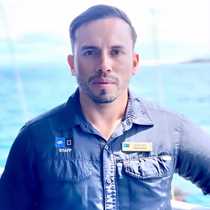Genovesa Island
National Geographic Islander anchored in the middle of a caldera belonging to an old dormant volcano. As we disembarked this morning, we could see how the sky was filled with birds; certainly this was the seabirds’ island. The shoreline was full of small coral pieces rolling with the waves; a white sandy beach welcomed us on our morning adventure.
There is no introduced species found on Genovesa Island, over time isolation had kept this place pristine and in its most natural state. Life over millions of years has evolved towards the surroundings and the natural behavior of the endemic species here. One single predator guarding the cliffs has lived with the rest of the birds. A predator camouflaged like no other, a day hunter known as the short eared owl.
During the morning we walked around several red-footed boobies nesting on the red mangrove trees; trees of life where you could see boobies of all ages, colors and sizes. Among the bushes some frigate birds were coexisting well with the boobies and had learned to share some nesting areas with the Nazca boobies. I was impressed by the many young night herons fishing from the tide pools during the low tide. Darwin Bay was the name of this incredible place where nature has no fear and everything was as wild as it could be. The blue world of this planet was explored by some of us snorkelers and many species of semi tropical fish were spotted as well as a curious hammered shark.
After midday, we explored the titanic cliffs surrounding our ship. A magical land full of life and interesting vegetation above the sea level, offered us a great landscape to admire. Storm petrels flying everywhere by the coastal area, while the owls were waiting to catch any of them down in the lava caves.
This was a week of knowledge, a time of peace and activity together; a dream that has come true for all of us. The Galápagos Islands showed us how humans and nature can coexist in a pristine world. These islands have shared feelings that will stay in our hearts forever.




